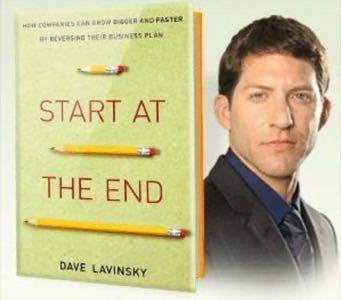
Many of today’s most successful businesses got their start without an apparent business model in mind (I’m looking at you, Facebook). But while drifting around for years as a free service without a clear path to profits might work for some businesses, it’s not a road that’s going to lead most startups to a good place.
That’s the clear message from Dave Lavinsky advocates in his new book Start at the End: How Companies Can Grow Bigger and Faster by Reversing Their Business Plan.
A serial entrepreneur who has started multiple companies, both Web and product-focused, Lavinsky is now cofounder of Growthink, a consulting firm that claims to have helped more than 500,000 entrepreneurs identify opportunities and grow their businesses. His reverse engineering approach has useful lessons Whether your business is just getting off the ground or in the early years of startup evolution.

Essentially, Lavinsky told ReadWrite, smart entrepreneurs start by defining the goals they want to achieve and working their way backward to arrive at the steps necessary for success. You might think you’ve already defined your goals, but Lavinsky is looking for much more detail than the vague goals created when businesses are formed.
Stereo Vision Statements
Start by creating two vision statements:
- One customer-focused (which most of us are familiar with)
- One from a business perspective, which is what sets Lavinsky’s ideas apart.
This vision includes not just your general business goal (Selling your company? Going public? Creating a business that spans three generations?), but also the financial metrics and business assets you’ll need to achieve that goal. In other words, if you want to sell your business, how much do you want to sell it for? $40 million? Then what are the financial metrics (dollar revenues, percent market share, dollar EBITDA, financial health ratios, etc.) that will get you there?
Once you’ve determined these visions, Lavinsky shows you how to assess the opportunities available to you; set annual, quarterly and monthly goals and milestones; and track your progress.
Pivots Are Part Of The Process
Lavinsky is well aware that the road to success is rarely smooth, and you might need to pivot before you hit your goal. “There are several roads you can take to your destination,” he says. “Pivoting is about choosing the best road for you and your company.”
When you pivot, Lavinsky explains, you’re changing your business model based on feedback from your customers and your market. “Because the new model is based on actual market data – as opposed to the “hunch” you had when you launched your company – it’s more likely to resonate with customers and yield more success than your previous business model.”
Sounds good, but how do you know when it’s time to pivot? “If you’ve been ‘spinning your wheels,’ then it’s time to pivot,” says Lavinsky. “If you’re continuing to work on your business and try new things, but without realizing the results you want, at some point, you need to come to the conclusion that either you’re not executing properly, or your business model is flawed.” In the former case, it’s time to bring someone in to help you execute; in the latter, it’s time to pivot.
Start at the End details several methods for identifying possible pivots and picking the best one for you, including:
SO Analysis: identifying your strengths and opportunities. “You’re only going to build a great business if your business plays to your existing strengths, so make sure it does,” explains Lavinsky.
Ansoff Matrix: the Ansoff Matrix helps determine the best new opportunities to pursue. Most important, it shows that any new opportunity targeting your current market (since you know and understand those customers) has a higher likelihood of succeeding.
Judge vs. Market Criteria: “When selecting a pivot, make sure the market is ripe for it,” cautions Lavinsky.
Pivoting is not something to take lightly, and you can’t do it every month, Lavinsky warns. “You need to pivot wisely and dedicate your company to pursuing it for a set period of time-perhaps six months or more.”
If you decide pivoting is right for your business, you need to adjust your business plan accordingly. “Most importantly, in your plan, determine how you will execute on the pivot, such as who will be responsible for what tasks and goals.” It’s also crucial to establish weekly, monthly and quarterly goals and milestones, Lavinsky says, and to constantly gauge your performance against these milestones.
Good Stuff At The End
Perhaps not surprisingly, one of the most useful sections of Start at the End comes near the end. “Multiplier Tactics” offers real-life approaches to turbocharge your business. My favorite example? The woman who had never worked in her late husband’s business until he left it to her, but then doubled its profits in a year by asking the managers to do more of the 5 things that worked best and less of the 5 things that worked least.
Lead image courtesy of Shutterstock.










